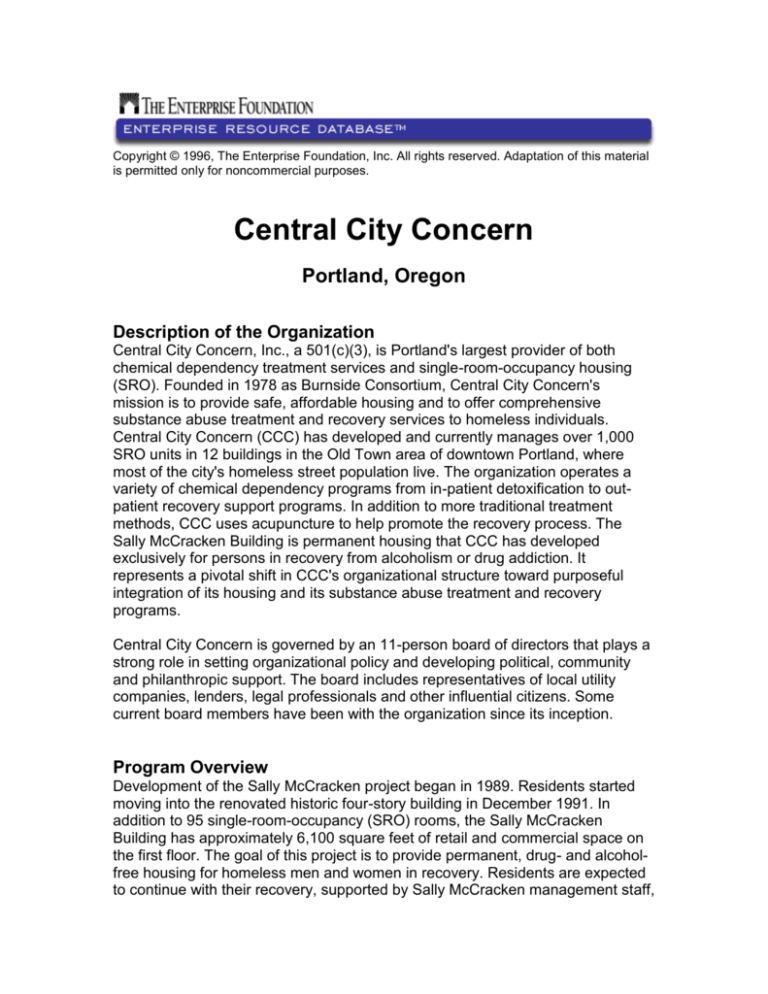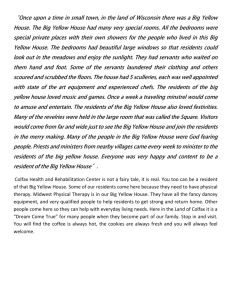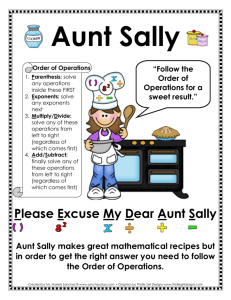
Copyright © 1996, The Enterprise Foundation, Inc. All rights reserved. Adaptation of this material
is permitted only for noncommercial purposes.
Central City Concern
Portland, Oregon
Description of the Organization
Central City Concern, Inc., a 501(c)(3), is Portland's largest provider of both
chemical dependency treatment services and single-room-occupancy housing
(SRO). Founded in 1978 as Burnside Consortium, Central City Concern's
mission is to provide safe, affordable housing and to offer comprehensive
substance abuse treatment and recovery services to homeless individuals.
Central City Concern (CCC) has developed and currently manages over 1,000
SRO units in 12 buildings in the Old Town area of downtown Portland, where
most of the city's homeless street population live. The organization operates a
variety of chemical dependency programs from in-patient detoxification to outpatient recovery support programs. In addition to more traditional treatment
methods, CCC uses acupuncture to help promote the recovery process. The
Sally McCracken Building is permanent housing that CCC has developed
exclusively for persons in recovery from alcoholism or drug addiction. It
represents a pivotal shift in CCC's organizational structure toward purposeful
integration of its housing and its substance abuse treatment and recovery
programs.
Central City Concern is governed by an 11-person board of directors that plays a
strong role in setting organizational policy and developing political, community
and philanthropic support. The board includes representatives of local utility
companies, lenders, legal professionals and other influential citizens. Some
current board members have been with the organization since its inception.
Program Overview
Development of the Sally McCracken project began in 1989. Residents started
moving into the renovated historic four-story building in December 1991. In
addition to 95 single-room-occupancy (SRO) rooms, the Sally McCracken
Building has approximately 6,100 square feet of retail and commercial space on
the first floor. The goal of this project is to provide permanent, drug- and alcoholfree housing for homeless men and women in recovery. Residents are expected
to continue with their recovery, supported by Sally McCracken management staff,
CCC and other substance abuse recovery programs. In 1993 the Sally
McCracken Building was a finalist for the David O. Maxwell Award of Excellence
from the Fannie Mae Foundation.
Target Population
Residents who live at the Sally McCracken Building are formerly homeless, lowincome men and women in recovery from chemical dependency. Some are also
diagnosed with mental illness. Income limits are based on Portland's Housing
Authority Section 8, Moderate Rehabilitation Rental Assistance program and are
below 60 percent of the median income threshold established by the federal LowIncome Housing Tax Credit program. Those residents whose incomes exceed
the Section 8 limit (currently, $16,200), must pay the full rent if they choose to
remain at the Sally McCracken Building. Residents' income levels range from no
income (nearly half of the residents as of September 1996), to $13,000. Of the
residents who have an income, the average is about $6,000.
At the time of the site visit (October 1993) 75 men and 19 women were living at
the Sally McCracken Building. Of the total resident population, 45 were employed
(21 full-time, 24 part-time), and 49 were unemployed. Unemployed residents'
income included Social Security and food stamps. Residents' ages ranged from
18 to over 55 years. There were 52 Caucasians, 24 African Americans, 12 Native
Americans and six Hispanic individuals. These figures have remained consistent
through 1996.
To qualify for housing, residents must be 18 years of age or older. Prior to
residency, applicants must have at least 45 days of documented sobriety, be
involved in an ongoing program of recovery and must be eligible for Section 8
assistance.
Building Features
The Sally McCracken Building is a four-story brick and masonry structure located
in Old Town, Portland's "skid row" area. There are three residential floors, two
with 32 private rooms and one with 31. Each floor has shared baths at a ratio of
about four residents per bathroom. Room sizes vary from 130 square feet to 160
square feet. All are equipped with sinks and refrigerators; 15 rooms have private
bathrooms. On each floor, one room with private bath is reserved for a live-in
monitor/building assistant. Each floor has a community kitchen/dining room,
which residents are encouraged to use for on-site recreation and socializing.
The first floor of the residential part of the building has: a spacious lobby; front
desk; small common room with a stereo, ironing board, and Nordic Track;
manager's office; and a library with an extensive collection of books. Twelve-step
recovery meetings are held in the library. The entryway is tiled, and the offices,
2
library and half of the lobby are carpeted. A coin-operated laundry facility is
located in the basement.
The building opens immediately to the public sidewalk and has no private outside
space. A park is just two blocks away, and the river front is six blocks away.
The front desk is staffed at least 16 hours a day. The ground floor entrance to the
building, the elevator and the main stairway are highly visible from the manager's
office and the front desk. Residents use a key to gain entrance to the building. An
alarm system was installed on the exit stairways, exit doors and on the doors
separating the commercial and residential space. Visitor access to residential
areas is controlled by an entry buzzer system that is connected to the front desk,
the manager's office and each security post. Security cameras monitor the front
door and the laundry room in the basement.
Support Services
The philosophy behind the Sally McCracken program is that housing and
treatment should be separate, and other than Alcoholics Anonymous (AA) and
Narcotics Anonymous (NA) support groups, no support services are offered onsite. However, a resident's right to stay in the housing is contingent upon
remaining alcohol- and drug- free. Residents are required to sign a lease
addendum that stipulates their continued sobriety and participation in recovery
programs.
Sally McCracken Building staff play an important role in supporting residents'
continued progress. Staff members assist residents in developing on-site AA/NA
meetings and other activities. They also work closely with CCC and other
chemical dependency treatment programs to help support the individual in his or
her recovery efforts. Staff stay informed about residents' participation in support
services through Portland's Homeless Alcohol and Drug Intervention Network, a
collaborative effort of all the public and nonprofit substance abuse agencies that
work with homeless people. Each agency's clients sign confidentiality releases
allowing the Network to discuss the care plans and status of their clients.
Through the network, Sally McCracken staff can monitor residents' compliance
with their treatment plans and intervene early with residents who are at risk of
relapse. Every quarter, the building manager makes contact with case managers,
counselors, sponsors or other persons who can verify tenants’ participation in
following their recovery plans. Staff members also are alert to signs of relapse
and contact a resident's case manager or counselor when intervention is
necessary.
3
Management Structure and Policies
Central City Concern manages the Sally McCracken Building; the organization's
administrative offices are six blocks away. In 1991, as an effort to facilitate
communication and collaboration between property managers and treatment
staff, CCC reorganized to integrate its housing and chemical dependency
programs under one supervisor. On-site management staff include a property
manager and three live-in building assistants.
Referrals come from the Estate and Everett Alcohol and Drug Free Communities
(transitional alcohol- and drug-free housing in the neighborhood), other
community treatment programs, social service agencies and self-referrals. The
Sally McCracken building manager accepts applications at the Sally McCracken
Building, screens applicants for sobriety eligibility and registers qualified
applicants on a waiting list. Applicants must also be approved for Section 8
eligibility by the local housing authority.
Sally McCracken Building management staff meet with prospective residents to
orient them to Sally McCracken Building's alcohol- and drug-free environment.
Residents are expected to help maintain the building's cleanliness and to behave
respectfully toward staff and other residents. Residents pay 30 percent of their
income toward the per-unit rent of $348, with the balance subsidized through the
HUD Section 8 SRO Moderate Rehabilitation Rental Assistance program.
The Sally McCracken Building is divided by floor into three small "communities."
Each floor has its own resident council, which gives the residents opportunities to
make decisions on house rules for their floor and to plan monthly dinners and
social gatherings. Building-wide events are also held, but on a less frequent
basis. The focus on sobriety creates a sense of security and community that is
crucial for many residents' continued recovery.
While six or seven units may be vacant at any one time, vacancies are filled
quickly. There is roughly a 50 percent annual turnover rate as individuals relapse
or move out after finding employment and improving their financial
circumstances. A resident whose occupancy is terminated because of relapse
may return to the Sally McCracken Building, but only after repeating the entire
application process, including 45 days of documented sobriety.
Community Relations
Strong support came from government officials and later from the neighborhood
and the business community. Central City Concern has an excellent reputation in
the community and is one of the biggest landlords and employers in the area,
which creates jobs for residents of Old Town. In addition, the residents have
begun to build their own relationships with the community through participation in
the neighborhood association and community block watch program.
4
Staffing
The staff at the Sally McCracken Building consists of a property manager and
three monitors/building assistants. All staff persons are, themselves, in recovery
from alcoholism or drug addiction. The manager is responsible for the operations
and community atmosphere in the building, ongoing monitoring of residents and
communication with the Homeless Alcohol and Drug Intervention Network and
the Alcohol and Drug Free Community Network. The monitor/building assistants
live in the building, each on a different residential floor. They function half-time as
floor monitors and the other half as building custodians. They are "the eyes and
ears" of the building, ensuring that residents who are struggling with their sobriety
and are at risk of or already in relapse are identified and assisted as early as
possible.
Volunteers from the community and the residents act as AA or NA sponsors for
other persons in recovery, contributing as many as 30 hours weekly.
Costs and Sources of Funding
Development
The Sally McCracken Building's development/permanent financing costs totaled
$4,409,465, which came from the following sources: $1.2 million loan (20 year at
11.75 percent interest from Security Pacific Bank, (now Bank of America);
$1,383,603 loan (30 year interest-only at 5 percent, with maximum payments of
$15,000) from Portland Development Commission; $159,000 equity from CCC;
$91,333 energy grant; and $1,575,029 in federal Low-Income Housing Tax Credit
equity syndicated by Enterprise Social Investment Corporation. In the event the
first mortgage loan from Security Pacific is called in year 10, the Portland
Development Commission will increase its loan amount to pay off the first
mortgage. The project also received approximately $600,000 through the
Investment Tax Credit for Certified Historic Renovations program.
Over a three-year period, the developer's fee for this project was approximately
$251,000, with $156,000 of that contributed to the project by Central City
Concern as an equity contribution. In addition, the developer provided an
operating deficit guarantee of approximately $105,000 until operating reserves
are funded at $200,000 and the project has been operating in the black for three
years. An incentive management fee of 50 percent of the cash flow will be paid to
Central City Concern once operating reserves of $350,000 have been
established.
Operations
Operating expenses total $1,853 per unit, per year, including total staff costs of
$80,421. Funding sources for operations include: rent subsidies from the HUD
Section 8 SRO Moderate Rehabilitation program; a $30,000 energy conservation
grant; grants and individual contributions totaling $60,000.
5
Results
The goal of the Sally McCracken Building is to provide affordable, alcohol- and
drug-free housing for persons in recovery from alcohol and drug dependence.
CCC projected a 50 percent success rate, success being defined as those
residents who maintain sobriety, continue their recovery programs and live
independently at the Sally McCracken Building or other permanent housing.
Since the Sally McCracken Building opened in December 1991, 337 individuals
have lived or are living in the building. Of the 337, 69.4 percent are clean and
sober. In addition, approximately 40 percent of the current residents are
employed. Many of the residents who leave the Sally McCracken Building do so
because their incomes have increased and they can afford better housing, and
because they have reunited with their families, including regaining custody of
their children. However, most of the residents make the Sally McCracken
Building their permanent home and continue to participate in structured programs
to meet their special needs.
Management works at being responsive to residents, who voice their satisfaction
and their complaints through the resident councils and informally through the
monitors or property managers. CCC has no formal resident satisfaction
measurement methods. However, staff members have found that the Sally
McCracken Building consistently has a longer waiting list of applicants than
CCC's other SRO buildings. They attribute this to the need for a long-term
alcohol- and drug-free environment, and the appeal the Sally McCracken
Building's supportive environment holds for homeless persons who are serious
about maintaining their recovery.
Comments
The Sally McCracken Building owes its effectiveness to the strengths of its
sponsor organization, CCC, including: understanding of the homeless population;
professional expertise in chemical dependency treatment and recovery,
especially among homeless and other low-income people; a uniform approach to
dealing with residents by both the housing and support services staff and strong
community and political support.
Central City Concern is satisfied with the Sally McCracken Building's design,
management policies and procedures and support strategies for residents. As a
result of the Sally McCracken Building's effectiveness and ongoing appeal to
prospective residents, CCC has successfully developed a second alcohol- and
drug-free permanent housing project. The Mark O. Hatfield Building consists of
106 units opened in August 1995.
6
Contact Information
Richard Harris, Executive Director
Central City Concern
2 NW Second Avenue
Portland, OR 97209
Phone: 503.294.1681
Fax: 503.294.4321
E-mail: richardh@transport.com
7







